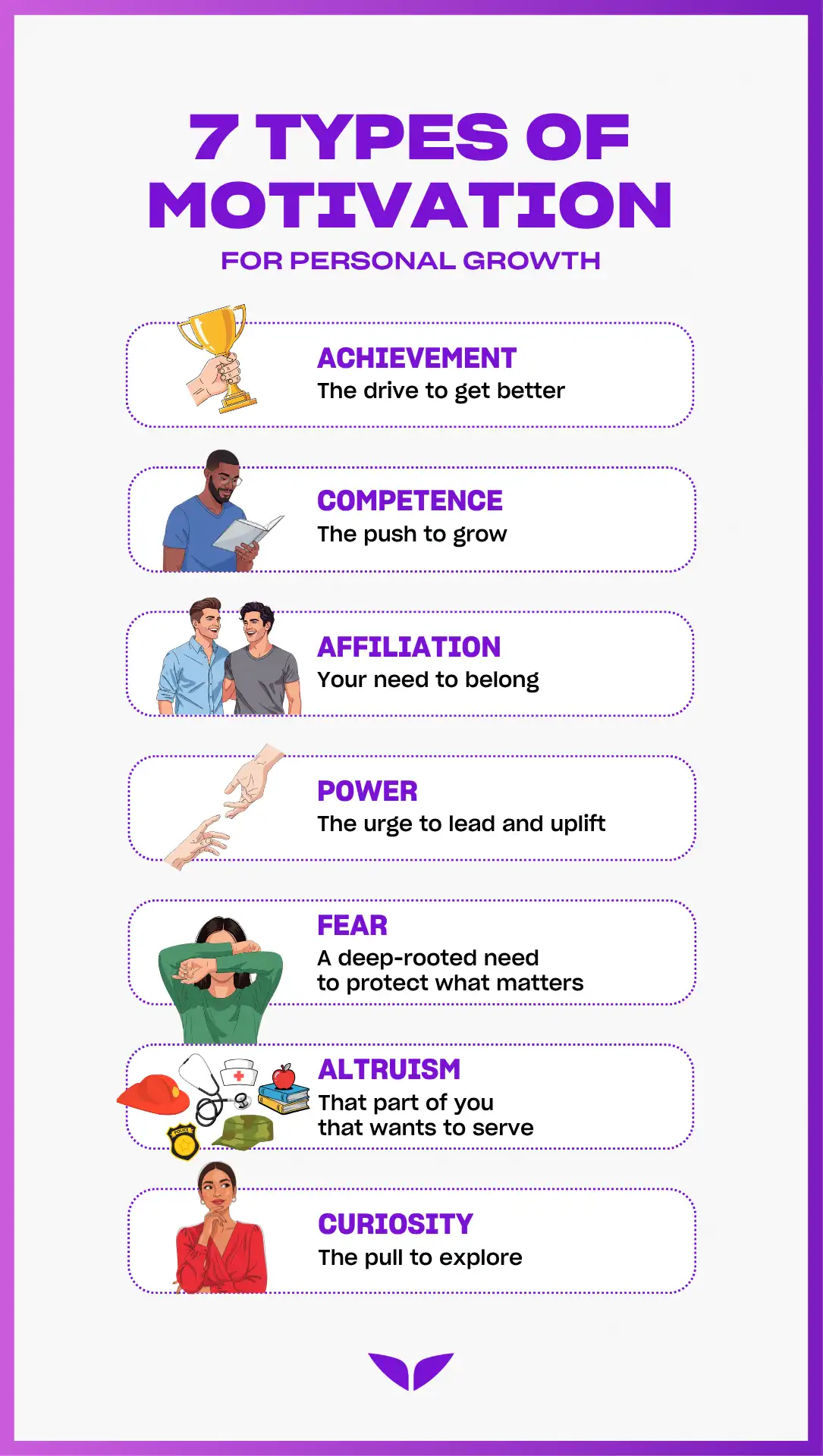You know those days when your drive feels electric? Ideas would flow, time would feel like it bends just for you, and every move you make would feel purposeful. But on other days, even a simple task can feel like climbing through mud.
The swing you feel from one extreme to the other happens because different types of motivation shape your decisions and momentum.
These inner patterns influence why you chase goals, stay focused, or lose steam halfway through. And once you learn how they operate, you can rewire the patterns behind your drive.
What is motivation, according to science?
Motivation, in simple terms, is what gets you to move. Researchers in psychology describe it as the process that guides your focus, effort, and persistence through almost everything you do.
Every choice you make runs on a blend of biology, emotion, and belief.
The gold standard for explaining the various types of motivation in psychology is self-determination theory. Psychologists Edward L. Deci and Richard M. Ryan developed self-determination theory to show that motivation operates along a spectrum. According to its framework, it’s easier to thrive with these three basic needs fulfilled:
- Autonomy, which is the sense that you’re in charge of your choices.
- Competence, or the feeling that you can improve and make progress.
- Relatedness, that is, the connection between what you do and why it matters, both to you and to others.
With all three checked off the list, there’s no need to “get in the mood” because it already feels like a natural state.
The hidden link between discomfort and drive
Nir Eyal, a habit formation expert and author of Indistractable, has a radical take on this mechanism, which he explores in depth in his Mindvalley program, Becoming Focused and Indistractable.
“Even when we think we’re seeking pleasure,” he says, “we’re actually driven by the desire to free ourselves from pain.”
In science speak, every action you take responds to some form of discomfort, secretly urging you to restore balance in your life. According to Nir, there’s a scientific name for this: the homeostatic response, which is the brain’s way of returning to stability.
This explains why so many of our distractions aren’t about the task itself but about escaping how we feel about it. And in real life, responding to this discomfort can look like:
- Seeking autonomy when you feel out of control.
- Building competence to overcome self-doubt regarding your abilities, or
- Reaching out for relatedness whenever you’re disconnected from others.
In all three cases, you can see how discomfort serves as the “messenger” that gets you back on track. And that inner pull toward balance is also what drives lasting achievement.
As performance psychologist Denis Waitley, the trainer behind the Mindvalley program, The New Psychology of Winning, says, “Human greatness can’t be extrinsically motivated. It must be compelled from within.”
What are the two types of motivation to know?
Motivation takes shape in two ways: through what happens outside you (extrinsic motivation) and what happens within you (intrinsic motivation). And understanding both sides of the spectrum is the first step toward mastering your own drive.
Here’s a look at these two types of motivation:
Extrinsic motivation
This is the type most people recognize first. It’s what happens when your effort is tied to an external reward or a result, from money and recognition to grades and approval.
In psychology, this sits on the controlled side of the motivation spectrum. What this means: your behavior is influenced by external factors rather than by your own choice. They spark action quickly but fade just as fast once the reward disappears.
Still, it has its place in life. External motivators can push you to start, especially when you pair them with purpose. And you can internalize them by finding personal meaning behind obligation.
Here’s where it helps to accept that you don’t just conjure your drive out of thin air, says Florencia Andrés, an international mindset coach.
In her Mindvalley program, The Champion Mindset, she says, “We need to stop waiting to feel motivated, and we need to start creating motivation.” This mindset shift is what transforms pressure into progress.
Intrinsic motivation
Now, this one’s the kind of drive that moves quietly from within. You read, create, or build not for praise or reward, but because the process itself feels meaningful or naturally satisfying.
This type of drive leans on the autonomous side of the motivation spectrum. And it grows when your work aligns with your values and strengths, often leading to the flow state, where time slips away amid deep focus.
At its core, intrinsic motivation is ultimately an identity game. “When you tie your goals to who you’re becoming,” says Florencia, “motivation takes care of itself.”
She’s spot on, because there’s such a thing as self-concordant goals. Turns out, people are far more persistent and fulfilled when their goals align with their sense of self.
How the two motivation types work hand-in-hand
No one runs purely on one kind of motivation. Both extrinsic and intrinsic forces shape how you move through life, and learning to work with both is part of finding your purpose.
This balance also defines the types of motivation in the workplace, where external rewards like recognition and growth opportunities meet internal drivers such as autonomy, purpose, and mastery. Together, they create an environment where productivity feels natural and engagement runs deep.
External rewards can set the pace, but they only carry you so far. What sustains your momentum is the meaning behind what you do, which is intrinsically derived.
Human greatness can’t be extrinsically motivated. It must be compelled from within.
— Denis Waitley, trainer of The New Psychology of Winning on Mindvalley
Diving deeper: 7 types of motivation explained
If you’ve ever wondered how many types of motivation there are, psychology identifies several key forms beyond just the “autonomous vs. controlled motivation” dive. Each one reflects a distinct inner force that shapes how you act, learn, connect, and grow.
Here they are, at a glance:
| Motivation type | Extrinsic or intrinsic | Key drive | Core expressions |
| Achievement | Intrinsic | Mastery and excellence | Continuous self-improvement, refining skills beyond goals |
| Competence | Intrinsic | Growth through challenge | Building confidence by testing limits and learning new skills |
| Affiliation | Extrinsic and intrinsic | Belonging and shared purpose | Collaborating, connecting, and thriving with community |
| Power | Extrinsic | Influence with intention | Leading with purpose, mentoring, and creating positive impact |
| Fear | Extrinsic | Avoidance of loss or discomfort | Using fear for clarity and direction so you take meaningful action |
| Altruistic | Intrinsic | Empathy and contribution | Acting in service of others, aligning effort with values |
| Curiosity | Intrinsic | Exploration and learning | Following your wonder, embracing new experiences for discovery |
Now, let’s take a closer look at them and how they influence the way you move through life, as explained by Denis and Florencia:
1. Achievement motivation
Achievement motivation is the quiet desire to get better, refine a skill, or reach a higher standard. It shows up when you keep improving long after the goal has been met, simply because progress feels meaningful on its own.
Think of a marathoner shaving seconds off their best time or a writer editing their tenth draft just to make one sentence sing.
“The quality of a person’s life,” Denis shares, “is in direct proportion to their commitment to excellence, regardless of their chosen field of endeavor.” And that commitment grows stronger each time you choose consistency over comparison and focus on mastery over milestones.
2. Competence motivation
Growth begins the moment you test your limits. Each challenge you take builds trust in your ability. And that steady push to learn and improve is the essence of competence motivation.
It’s why people sign up for public-speaking classes after years of avoiding the stage or learn to code to expand their design craft.
“Every time you take action, even when you don’t feel ready,” says Florencia, “you build evidence that you can trust yourself.”
So, the more you act from that trust, the stronger your confidence becomes.
3. Affiliation motivation
As Denis says, “The greatest people in all walks of life achieved their greatness out of a desire to express something within themselves that had to be expressed.”
When that expression occurs within a community, belonging becomes a shared purpose.
You can see it in a start-up team pulling late nights because they believe in the same vision, or in an artist collective sharing ideas that make each person’s work stronger.
Scientifically speaking, it all boils down to the fact that we’re all wired to connect, and collaborating with others deepens every pursuit. Research shows that people with strong social bonds experience higher motivation and greater well-being.
4. Power motivation
There’s a natural drive in many of us to shape outcomes and take responsibility for change. Influence, when guided by intention, becomes service.
Case in point: the school teacher who leads with empathy or your favorite corporate manager who mentors others to grow beyond their own role.
As Florencia teaches, “When you lead with intention instead of ego, influence becomes impact.” It’s in that space that influence transforms into genuine leadership, the kind that uplifts others while keeping you grounded in purpose.
5. Fear motivation
Fear often signals what truly matters, and sometimes the push to move comes from what you don’t want to lose. When you meet it with awareness, it transforms into clarity.
The common ground between a new parent who gets serious about health after a scare or an entrepreneur who finally launches after a layoff? Both fear, yet move forward anyway.
“Discomfort,” Nir says, “is the seed of growth. When you learn to sit with it, you discover what truly drives you.” And listening to what fear reveals is how you turn tension into direction.
6. Altruistic motivation
Empathy fuels action. It’s why people volunteer to spend weekends planting trees or why leaders donate profits to causes they care about.
“The success of our efforts,” shares Denis, “depends not so much on the effort itself, but on our motive for doing it.” So, when your reason for acting aligns with your values, contribution becomes fulfillment.
Every act of service strengthens the sense that what you do matters, not just for others but for who you’re becoming.
7. Curiosity motivation
Every spark of curiosity opens a new door. It’s the pull toward the unknown, the desire to explore, ask questions, and see what happens next.
You can spot it in a traveler choosing a country they know nothing about or a scientist spending months testing a single idea.
Like Florencia says, “Growth begins the moment you say yes to what scares you a little.”
Here, curiosity keeps your energy alive, feeding that hunger to learn and stretch beyond what’s familiar. In this space, discovery becomes its own reward, and the process feels just as fulfilling as the outcome.

How to use different types of motivation to fuel your productivity
You don’t just simply lack motivation; it’s often your environment that saps it out.
Think about it. You can wake up full of ideas and still feel them fade by noon. And not because the drive is gone, but because it’s being pulled in too many directions.
“Distraction is always an unhealthy escape from reality,” explains Nir. “Once you understand the discomfort driving it, you can regain control.” Self-awareness, in this case, is the bridge between losing focus and finding it.
Once you know what motivates you and why, you can shape your environment to meet you where you are with these steps:
1. Match the motivation to the moment
Not every task needs the same kind of fuel. Some days call for a quick push; others need deeper meaning to keep you going.
So, think of extrinsic and intrinsic motivation as two gears in the same system. One gets you moving, the other keeps you going.
When you start something new, use extrinsic motivation to build momentum:
- Set clear goals. Pick one target you can measure.
- Stay accountable. Tell someone what you’re working toward.
- Reward progress. Celebrate small wins, not just big outcomes.
Then, as you settle into the process, tap into intrinsic motivation to sustain focus:
- Anchor your “why.” Connect your task to your values or long-term purpose.
- Notice what feels good. Let satisfaction, not stress, guide your pace.
- Self-reflect. Ask yourself, “Who am I becoming by doing this well?”
When you know which kind of energy the moment asks for, it’s easier to focus. And progress? It starts to build on itself.
2. Design your space around your motivators
Your environment can either drain or drive you. The difference lies in whether it supports what naturally fuels you.
“Motivation,” says Florencia, “doesn’t just appear; you create the conditions for it.”
Here are a few examples of how to do so, based on what reins you in.
- For achievement-driven minds: Keep progress visible. Use a board, journal, or tracker to track your wins as they accumulate.
- When competence is your spark: Build in challenges that stretch your limits. Learning something new keeps your energy alive.
- For those wired for affiliation: Thrive in shared momentum. Choose workspaces or circles where ideas and encouragement flow.
- If altruism moves you: Stay close to the impact. Keep reminders of who benefits from your effort. This turns consistency into contribution.
The easier your space supports your motivators, the longer your focus lasts.
You build motivation by moving, not by waiting for it to arrive.
— Florencia Andrés, trainer of The Champion Mindset on Mindvalley
3. Reconnect to your purpose when energy dips
Even the most focused people lose steam. When that happens, don’t push harder. Realign. Better still, pause and ask yourself, “Why did I start this?”
Sometimes that single question is enough to reset your energy. But if it isn’t, try one of these:
- Look at the impact. Think about who benefits from your work. It can be a client, a team, or even your future self.
- Review your wins. Scan your progress so far. Momentum often hides in what you’ve already done.
- Revisit your “why.” Write it down in one sentence. Keep it somewhere you can see when focus fades.
- Change your immediate environment. A brief walk, a new playlist, or a light stretch can help your body reconnect with purpose through motion.
So instead of chasing productivity hacks, come back to meaning.
“The greatest achievers,” says Denis, “see every obstacle as an opportunity to perform at their best.” Reconnecting to your “why” works the same way; it turns resistance into fuel and fatigue into focus.
Struggling to remember your true north? Let Nir guide your path forward:
4. Reset your focus with curiosity
When your focus starts to slip, don’t fight it. Shift it with intrigue. It can help you master how to get into flow faster than force ever will.
Try asking yourself:
- “Is there anything to learn from this?”
- “What would happen if I tried a new approach?”
- “What’s one part of this task I haven’t looked at yet?”
Questions like these pull your mind out of resistance and into a state of awareness. Once you notice what’s really happening underneath all those distractions, it’s easier to redirect your attention intentionally.
As Nir puts it, “Every distraction is just an impulse that can be understood and redirected.” And with awareness, you get to transform frustration into direction.
5. Keep your energy in motion
Motivation isn’t a one-time spark. You can think of it as an ongoing rhythm. Some days it’s loud and obvious; other days, it hums quietly underneath.
What matters most is that you keep it moving.
When your drive starts to fade, shift your state before you lose momentum with these steps:
- Move your body. A short walk, a five-minute deep stretch, or even a few deep mindful breaths can clear mental fog faster than overthinking.
- Change your scenery. Step outside, tidy your desk, or light a candle. Any slight shift in your immediate space often resets your mental space, too.
- Switch your task. Can’t stay focused? Jump to something simpler for a while. Sticking to action mode keeps your momentum going.
As Florencia says, “You build motivation by moving, not by waiting for it to arrive.”
Awaken your unstoppable
Whether navigating the types of motivation for the workplace or your personal life, it all begins with knowing what truly drives you, then learning how to work with it.
Now, Nir Eyal’s free Becoming Focused and Indistractable masterclass is a great starting point for that. It’s a glimpse into his full Mindvalley program that helps you reclaim your attention from the clutches of distraction and power up your drive to thrive.
In this 26-minute class, you will:
- Identify the four hidden triggers that make you fall for distractions,
- Use Nir’s 10-minute time-boxing method to bring structure to your day,
- Shape physical and mental environments that protect your attention, and
- Strengthen your motivation through awareness, balance, and intentional recovery.
For Wioleta Wydrych, a success coach for coaches from the U.K., Nir’s lessons have changed how she works and how she feels. She shares:
Learning with others in this course helped me to implement so much that I feel on fire now.
And today, she’s so much more centered. “I’m already ahead of schedule, more organized, and aware of when I get distracted so I can reset fast,” she adds.
Her story shows that motivation becomes steady when you learn how to sustain it. And with Mindvalley by your side, you’ll have the right resources and community to keep your inner drive alive.
Welcome in.











